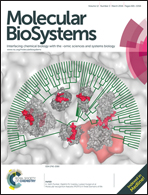Identification of epitope-based peptide vaccine candidates against enterotoxigenic Escherichia coli: a comparative genomics and immunoinformatics approach†
Abstract
Enterotoxigenic Escherichia coli (ETEC) associated diarrhea remains a global killer with an estimated annual incidence rate of 840 million infections and 3 800 000 deaths worldwide. There are no vaccines available for ETEC and the traditional vaccine development approach is arduous and time consuming. Thus, alternative in silico approaches for epitope prediction have engrossed the interest of researchers to reduce resources and time of vaccine development. Computational approaches are playing a crucial role in fighting against rapidly growing infectious organisms. In this study we employed an integrated comparative genomics and immunoinformatics approach for proteome scale identification of peptide vaccine candidates. The proteins shared between both ETEC E24377A and H10407 strains, but lacking in commensal E. coli SE11, were subjected to immunoinformatics analysis. For a protein pool shared between different pathogenic ETEC strains, we investigated varied physicochemical and immunogenic properties to prioritize potential vaccine candidates. Epitopes were further tested using docking studies to bind in the MHC-I binding cleft. Predicted epitopes provided more than a 95% population coverage in diarrhea endemic regions presented by major MHC-I supertypes, and bind efficiently to a MHC molecule. We conclude by accentuating that the epitopes predicted in this study are believed to accelerate the development of successful vaccines to control or prevent ETEC infections, albeit the results require experimental validation using model organisms. This study underscores that in silico approaches, together with omics data, hold great potential to be utilized for rapid and reliable genome-wide screening for identification of vaccine candidates against devastating infectious diseases.


 Please wait while we load your content...
Please wait while we load your content...